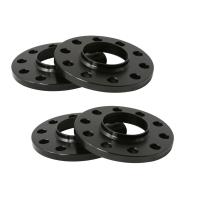 DO NOT ADD "NOTES TO THE SELLER" DURING CHECKOUT
DO NOT ADD "NOTES TO THE SELLER" DURING CHECKOUT We strive to ship your order as fast as possible so we utilize an
automated processing system. Because of this, these messages are
not displayed and will not be seen by any of our staff. If you have
questions/requests/comments/information, send us an eBay message or
give us a call
 Measure Vehicle & Wheel Bolt Patterns
Measure Vehicle & Wheel Bolt Patterns Please be sure to measure the bolt pattern of both your vehicle
and the wheels. Since 4-lug, 5-lug, 6-lug, & 8-lug patterns are
measured differently, use the "Bolt Pattern Diagram" above to
ensure it is measured correctly.
 Important Safety Advisory
Important Safety Advisory As with any component you purchase for your vehicle, installation
should be done by a qualified technician. We've provided the
following information as a general reference for purchasing and
installing these spacers/adapters. The following list isn't
all-inclusive and may be different depending on the vehicle you
drive, type of wheels you have, and ideal setup you're trying to
achieve. Failure to install properly may cause your lug nuts/wheel
studs/spacers to loosen or break while driving. If you are not
confident or familiar with the installation, please ask a trained
professional for help. As shown in the pictures, these spacers do
not have a wheel-centric lip. If your wheels do not use
conical/cone seat lug nuts, there is a high chance it will not
center properly which could result in steering wheel vibration.
 Hubcentric Rings / HubRings
Hubcentric Rings / HubRings - If your vehicle hub is smaller than 87.1mm, these spacers will
not properly center around your hub which could cause steering
wheel vibrations. We recommend purchasing hubcentric rings to
reduce/prevent steering wheel vibrations.
 Before Purchasing
Before Purchasing - Measure your wheel gap for clearance. You will need at least
1.5" (38mm) of clearance to prevent the wheel/tire from hitting the
fender or fenderliner. - The vehicle’s wheel studs need to be
measured. If the studs are longer than 1.5" (38mm), it will extend
past the spacer's surface. It may not be possible to bolt the wheel
safely onto the spacer, depending on whether your wheels have
pockets/cavities around the mounting pad. - If your vehicle does
not have 1/2"x20 threaded wheel studs, you would need to purchase
the correct threaded lug nuts for proper installation.
 During Installation
During Installation - Installation should be performed by a trained professional using
proper tools. - Avoid using an impact wrench or any pneumatic
tools; improper usage may cause damage to components. - Ensure
proper thread engagement. Typically, its a minimum of 5-8 turns
before the lug nut tightens, however, it varies depending on thread
pitch and type of vehicle. - ALL Lug Nuts (on the spacers and the
wheels) MUST be torqued to manufacture specifications.
 After Installation
After Installation - Test drive your vehicle to ensure the hardware is installed
properly. Pay close attention for any noises, vibrations, or
compatibility issues (such as fender rubbing). - Inspect and
re-torque ALL lug nuts after 25-50 miles of driving. This requires
you to take off the wheels to tighten the lug nuts holding the
spacers to your vehicle.







